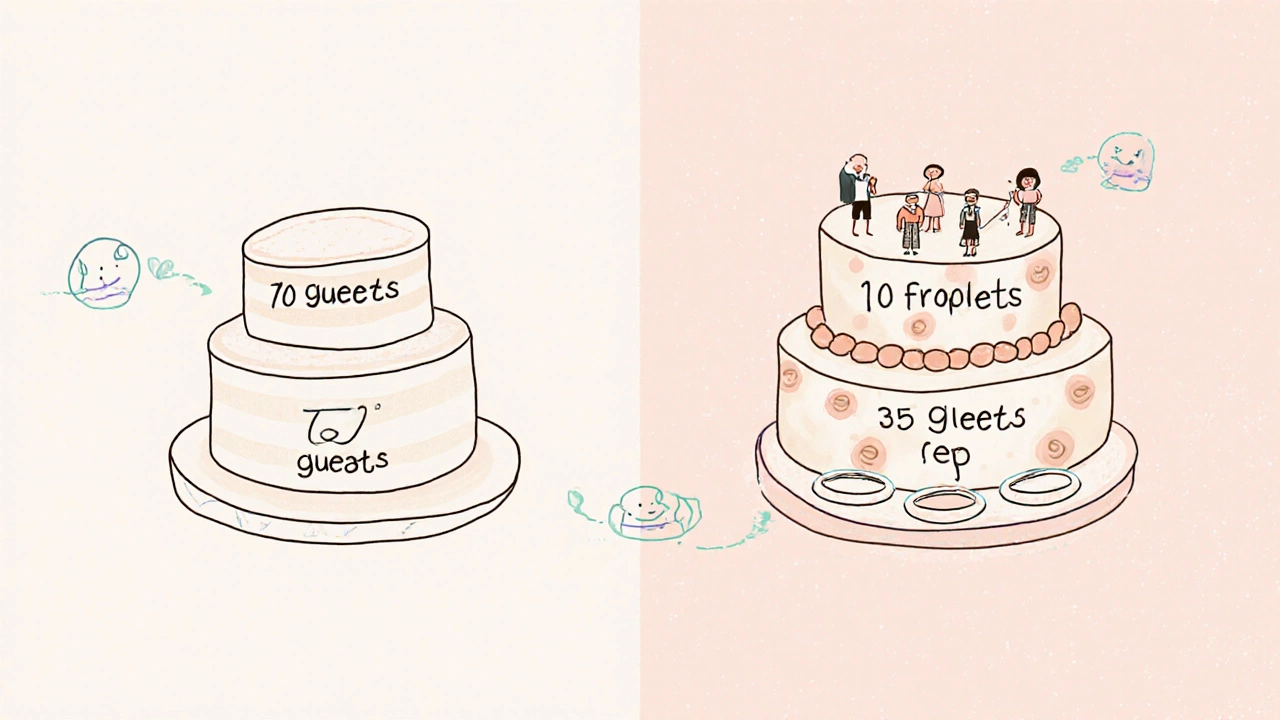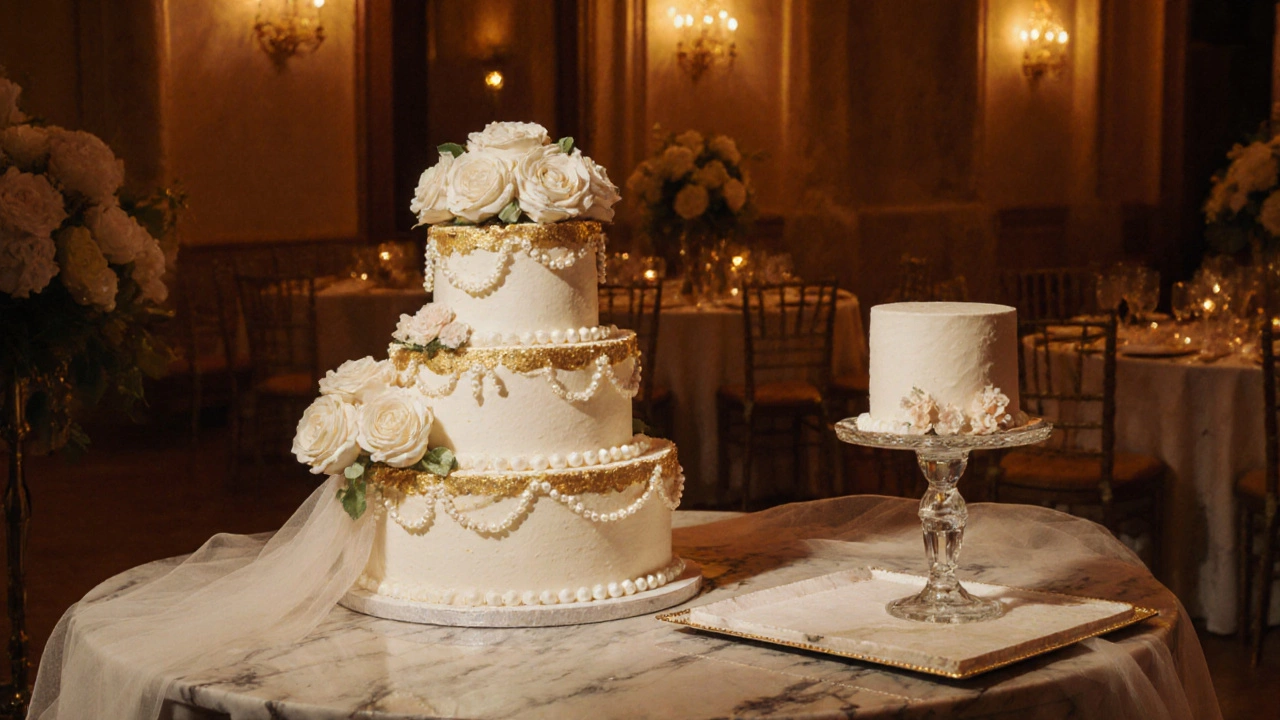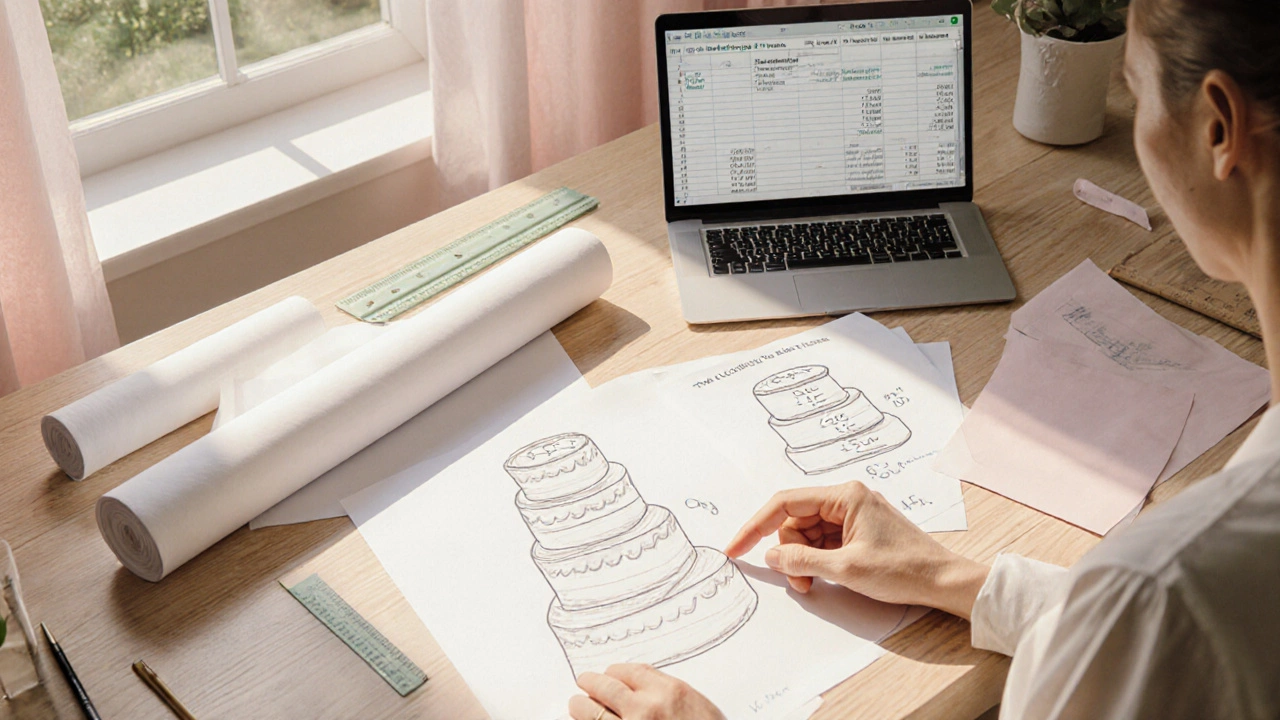Wedding Cake Tier Calculator
Planning a wedding cake that feeds 100 people can feel like a math puzzle, especially if you’ve never dealt with tiered cakes before. The good news? You don’t need a PhD in pastry science-just a clear set of numbers and a few realistic assumptions. Below you’ll find a step‑by‑step guide that tells you exactly how many wedding cake tiers to order, how big each tier should be, and what budget impact you can expect.
What a Guest Serving Size Means for Your Cake
Before we talk tiers, let’s nail down the basic unit: a slice. Most bakers use a guest serving size of roughly 100‑120 grams, which translates to a 2‑inch by 2‑inch piece. That weight feeds a typical adult without leaving anyone hungry or causing excessive waste.
If you prefer a more generous portion-say for a dessert‑first wedding-you can bump the slice to 130‑150 grams. For a modest serving (kids or a sweet‑tooth light menu), 90 grams works fine. Choose the size that matches your overall menu and budget.
Typical Tier Dimensions and Their Guest Capacity
Most professional bakers standardize tier diameters in inches. The most common lineup looks like this:
| Tier Diameter | Height (inches) | Approx. Guests Served |
|---|---|---|
| 6 | 4 | 20 |
| 8 | 4 | 35 |
| 10 | 4 | 50 |
| 12 | 5 | 70 |
| 14 | 5 | 90 |
| 16 | 5 | 110 |
These numbers assume a standard 100‑gram slice. Adjust the guest count upward if you go with a larger slice, or downward for a smaller one.
Step‑by‑Step: Calculating the Right Number of Tiers for 100 People
- Decide your slice size. For this guide we’ll use the middle ground of 100 g.
- Choose a base tier that comfortably fits the largest number of guests you can serve without looking over‑filled. In most cases a 12‑inch tier (about 70 guests) works well for 100 people.
- Subtract the base tier capacity from your total: 100 - 70 = 30 guests remain.
- Pick the next smallest tier that can cover those 30 guests. An 8‑inch tier serves roughly 35 guests, so it’s enough.
- Now you have a 12‑inch bottom tier and an 8‑inch middle tier, covering 105 guests-slightly over, which gives you a safety buffer for larger slices or unexpected extra guests.
- If you prefer a more balanced look, add a third tier (6‑inch, 20 guests) and reduce the bottom to 10‑inch (50 guests). That layout serves 120 guests total, still within budget.
In short, for 100 guests you’ll typically need two tiers (12‑inch + 8‑inch) or three tiers (10‑inch + 8‑inch + 6‑inch) depending on aesthetic preference and how much wiggle room you want.

Flavor, Design, and How They Influence Tier Choice
While size drives the math, flavor and design affect the final decision in subtle ways. Dense flavors like chocolate fudge or caramel can be heavier per slice, meaning you might need slightly fewer guests per tier. Light flavors (lemon, mousse) are airy, so a 100‑gram slice feels less filling-consider adding a small extra tier if you think your crowd prefers lighter desserts.
Design elements such as intricate fondant work, sugar flowers, or a heavy ganache coating add weight, too. Communicate these details with your cake decorator early on; they can adjust the tier dimensions or suggest a sturdier tier board to avoid collapse.
Budget Impact: What Each Extra Tier Costs
Every additional tier adds labor, ingredients, and structural support. On average in New Zealand (2025 rates):
- Base tier (10‑inch): NZ$600‑$800
- Mid tier (8‑inch): NZ$450‑$600
- Top tier (6‑inch): NZ$300‑$450
- Custom design surcharge (fondant, sugar art): +15‑% per tier
- Tier stand and delivery: NZ$150‑$250
If you opt for the two‑tier solution (12‑inch + 8‑inch), expect a total around NZ$1,300‑$1,600. Add a third tier and the bill climbs to roughly NZ$1,700‑$2,000, depending on design complexity.
Remember, a modest “cake‑only” budget can be stretched by trimming filler layers (e.g., fewer vanilla buttercream layers) while keeping the decorative top tier intact.

Practical Tips & Common Pitfalls
- Order a little extra. A 5‑10 % over‑order cushions against larger slices or unexpected guests.
- Ask your baker for a cake slice weight chart; it helps you visualize portion sizes.
- Coordinate the cake stand early. A flimsy stand can cause a multi‑tier cake to tip, especially on uneven venue floors.
- If you have a dessert table with other sweets, you can safely drop one tier and rely on cupcakes, macarons, or a fruit platter to fill the gap.
- Consider a “cut‑away” cake for the reception and a smaller “display” cake for photos. The display cake can be 2‑3 tiers smaller, saving money while still looking grand.
Quick Reference Checklist
- Determine slice size (90‑150 g).
- Choose base tier size (usually 12‑inch for 100 guests).
- Calculate remaining guests and add appropriate mid/top tiers.
- Factor in flavor weight and decorative elements.
- Set a realistic budget per tier (+15 % for custom design).
- Confirm cake stand, delivery, and onsite storage.
- Place order 8‑12 weeks ahead; schedule a tasting.
How many slices does a standard 12‑inch tier provide?
A 12‑inch tier, baked 4‑5 inches high, typically yields about 70 slices of 100 g each. The exact number can vary with slice shape and frosting thickness.
Can I use a smaller slice for kids and still feed 100 adults?
Yes. If you serve a 90‑gram slice to children, you’ll need a few extra slices for adults. A two‑tier (12‑inch + 8‑inch) cake still covers the total, but add a small buffer of 5‑10 extra servings.
Is it cheaper to have a three‑tier cake than a two‑tier cake?
Generally, no. Adding a tier adds labor, ingredients, and sometimes a sturdier stand. However, if you choose simpler flavors on the extra tier, the price gap can narrow.
What’s the best way to transport a multi‑tier cake?
Use a refrigerated truck or a temperature‑controlled vehicle. Secure each tier on a sturdy cake board, and keep the tiers stacked vertically on a non‑slipping rack until they reach the venue.
Should I order a display cake and a separate serving cake?
Many couples do. The display cake can be smaller and highly decorative, while the serving cake (often a simpler sheet cake) handles the bulk of the slices. This approach can reduce costs while keeping the visual impact.

